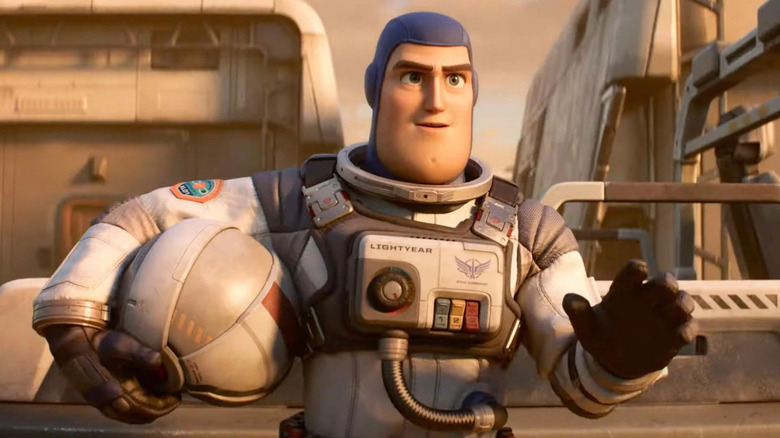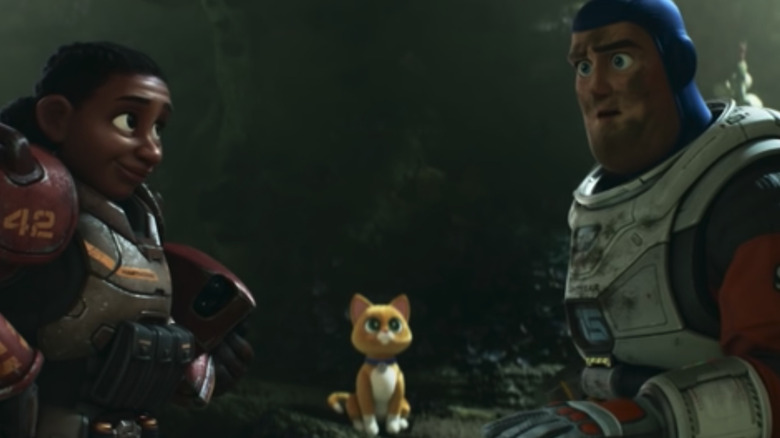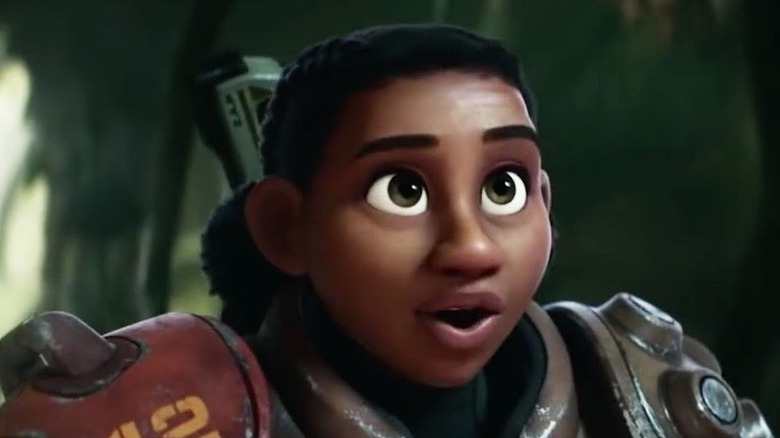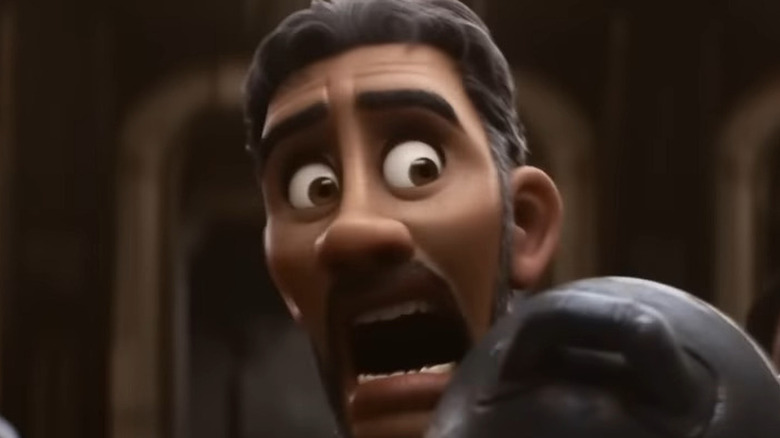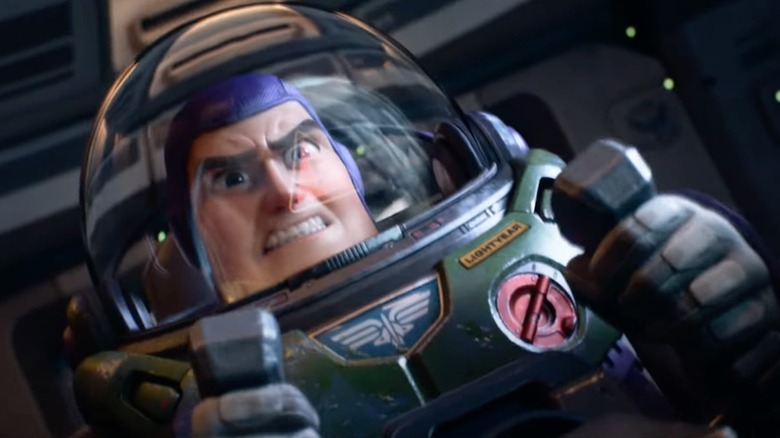The Best And Worst Moments In Pixar's Lightyear
Major spoilers for "Lightyear" follow.
There is a shot about two-thirds of the way through "Lightyear" that takes my breath away. Cast against a Grimace-purple sky, Buzz Lightyear (Chris Evans) sinks to his knees in defeat; a hostile planet's atmosphere kicks up dust, and his head bows like that of so many beaten heroes before him. The image is technically and effortlessly brilliant. We, as an audience, are all too used to it.
If anything sinks the latest Pixar film, which is directed by studio regular Angus McClane, it's the familiar elements that it's built from. "Lightyear" marks the fifth big-screen appearance of a character who debuted almost 27 years ago; the script traffics in the studio's favorite tropes more routinely than "Soul" or "Turning Red," and relies on a host of science fiction cliches.
And yet, nothing about "Lightyear" is disposable. For a film that some questioned the purpose of, McClane's movie is remarkably rich in singular joys. There is a hat that coughs up blowtorches. Taika Waititi makes sandwiches where the bread is on the inside. We've had Pixar and Buzz Lightyear in our collective lives for so long that it's difficult to suss out the great from the mediocre. In the words of Buzz Lightyear, this article finishes that mission. Here are the best and worst moments from Pixar's "Lightyear."
Best: The title card
At the beginning of "Lightyear," a title card appears that consists of only three sentences: "In 1995 Andy got a toy. That toy is from his favorite movie. This is that movie."
What a flex. After months of consternation about why "Lightyear" exists, the movie spells it out plainly: "Lightyear" is a movie that Andy loved. So, he got an action figure inspired by it. Andy is like many of this site's readers, a person who liked a work of art enough to ingratiate it into his daily life, if only through imaginative play. That's lovely.
It also sets an incredibly high bar for "Lightyear" as a film — and part of the joy in watching "Lightyear" is seeing how it subverts the expectations it sets for itself. Buzz has to be charming, funny, and heroic enough to capture Andy's heart. There have to be moments for Andy's parents to connect with, too. "Lightyear" succeeds on both fronts. The title card lays out the thesis of "Lightyear" in plain English and gives the film a runway from which it can achieve liftoff. It's excellent.
Worst: The title card
At the beginning of "Lightyear," a title card appears that consists of only three sentences: "In 1995 Andy got a toy. That toy is from his favorite movie. This is that movie."
It confuses the entire point of the film. Yes, there are great things about the title card — I literally just praised it — but think about that premise more closely. This is a movie that Andy loved. What resonance, then, is it meant to have for us? Andy, bless him, is anything but the heart of the "Toy Story" films. The film that he plays the most active role in, "Toy Story 3," explicitly addresses how little we know about Andy and the limits of his toys' love and faith in him. Centering a film around Andy's opinions may dull its impact for many viewers.
Taken on its own terms, "Lightyear" is still a rip-roaring space adventure. It's also one that risks feeling pointless without that meta framework. Most of the audience is so familiar with the small, plastic version of Buzz that watching a flesh-and-bone version of the character with zero context would be inherently head-scratching. But with this solution, Andy becomes a cipher for anyone who hasn't seen the "Toy Story" movies, one that the movie never addresses again. This is all more complicated than "Inception" and "Memento" combined, and that's an unfortunate beginning for a film that's trying to tell a soaring adventure story.
Best: A series of failed missions
No matter what audiences expected from "Lightyear," a resemblance to "Up" probably wasn't it. "Up," however, is exactly what the most moving segment of Angus McClane's movie channels during a montage in which Buzz Lightyear attempts to complete his mission and jumps several years into the future each time that he fails. For Buzz, these mistakes make up a few minutes. For his dear friend Commander Alisha Hawthorne (Uzo Aduba) and the humans stranded on T'Kani Prime, however, it's enough time to fall in love or start a family. Every time that Buzz returns, we see Hawthorne's life and the T'Kani Prime settlement expand. These changes are lovely, funny, and — eventually — heart-shattering.
62 years. That's how much time Buzz misses with the only friends he has left. Their lives pass by in the blink of an eye while he is trying to serve the mission. When, after a deflating and desperate attempt, he returns to Hawthorne's quarters and finds an almost empty room, the audience knows instantly what has happened: Hawthorne passed while Buzz was gone. His devotion to making things right cost him the chance to say goodbye.
Buzz doesn't fully comprehend the weight of this revelation at first (although, given the tears he sheds, it's still quite heavy), but anyone watching will. Will Buzz come to understand that he's more than his accomplishments and mistakes? That is the haunting question that "Lightyear" asks, and it's never more clear than during this sequence.
Best: Whatever Sox the Cat does
Sox the robot cat is not the bad guy in Pixar's "Lightyear" (spoiler: that's Buzz!), but he will destroy my critical faculties for the next 200-odd words. Every cat parent is going to fall for Sox. He's too impeccably animated, too cat-ish, and too exactly what a futuristic robot cat companion ought to be. When Sox shoots a tranquilizer dart from his mouth to save Buzz and whispers "I bought you five minutes" in a tenor-pitched monotone, it's just as simultaneously loving and removed as every real-world cat on Earth. The shot of Sox clinging to Buzz's leg in terror lives rent-free in my brain. Objectivity is dead, long live objectivity.
Thematically, Sox is important because Buzz Lightyear takes love for granted. He doesn't nurture the connections he has with others. Conversely, he doesn't see himself as worthy of love when he fails. Sox offers Buzz a chance to do the former, and provides him affection when the latter occurs. In his constant and very family-friendly way, Sox embodies the themes of "Lightyear" at Earth-level, no matter how high the film and its characters try to fly away from them. Sox isn't the bad guy — he's the film's best character.
Worst: The infiltration sequence
Sox feels like an idiosyncratic creation, a specifically madcap character constructed for a particularly resonant film. The same can't quite be of the volunteer defense corps headed by Izzy Hawthorne (Keke Palmer). While Mo Morrison (Taika Waititi) and Darby Steel (Dale Soules) are enjoyable, they're also cliches. Mo flirts with emotional complexity when his clumsiness almost kills Socks, but that beat is better executed through Izzy's poor judgment during a thrilling, mid-film escape sequence. Unlike the best Pixar movies, "Lightyear" isn't an ensemble picture.
This shortcoming most clearly reveals itself during a lackluster infiltration sequence. It should be an exercise in both fun and nerve-jangling tension. Instead, it's sort of bland. Buzz and the corps break into an abandoned military garage to acquire a ship for their mission. Once inside, they notice rows of egg sacks on the ceiling. Mo accidentally sets off an alarm, the eggs hatch, and a slew of bugs spill out. This all sounds grosser and more exciting than it is. We can see Mo's clumsy mistake coming from a mile away, and we're aware that the film needs Mo and the gang to emerge unscathed. As a result, the infiltration lacks emotional stakes, and it's not particularly interesting to look at, either. It might be thrilling for a six-year-old who has never seen a movie before — hey there, Andy — but it's not for the rest of us.
Best: The meat sandwiches
Mo is a fan of sandwiches, but not as we know them. During a fairly quiet sequence, he and the team kick back and grab grub while Sox recharges. What does the vending machine have? Meat sandwiches — as in two slabs of meat on the outside, and one slice of bread in the middle. It's an absurd visual gag that, in classic Pixar fashion, proves more crucial than anticipated.
Buzz Lightyear resists evolution. He chooses a decades-old mission over his friends, the memory of his old home over his current one, and the army's creed over the feelings inside his heart. Buzz initially views the meat sandwich as obscene. However, as he takes in the vulnerability of the ragtag bunch he commands, whatever keeps Buzz rigid and sandwich-resistant softens. Five or so minutes later, Buzz takes a hulking bite of the meal. He smiles. A meat sandwich, no matter how you slice it, is good. The process of enjoying one matters. "Lightyear" sneaks this lesson into the film through a scene that's both tasty and profound. It's one of the movie's finest gestures.
Worst: Zurg revealed
In an excellent article for the Ringer titled "How Pixar Solved the Villain Problem," Keith Phipps dives into what makes the company's stable of bad guys so compelling. The answer he arrives at is that they make a plausible case for themselves. "With just a little less virtue and backbone," Phipps writes, "most of Pixar's heroes could end up on the wrong side of their films' moral dilemmas." That proves quite true in "Lightyear."
For most of the movie's runtime, Buzz's rival is a villain named Zurg. Near the movie's halfway point, it is revealed that Zurg is actually an elderly Buzz Lightyear. Older Buzz has broken time itself, and traveled back several decades to retrieve the hyperspeed crystals. Why? To finally "complete the mission" and get home after all this time. At first, Buzz and Older Buzz see eye to eye. Their bond disintegrates, though, when Buzz watches Older Buzz compromise the lives of everyone in this timeline for his singular, centuries-old dream.
This all works well on paper. It doesn't in practice. The issue isn't whether or not Older Buzz has a point. The problem is that Buzz Lightyear himself isn't tremendously compelling. Chris Evans' Buzz is a riff on a character we've known and loved for decadesand, while he's worthy of empathy and he's well-acted, he's less easy to invest in than other recent Pixar protagonists. Older Buzz may have some points, but they're easy to miss in "Lightyear."
Best: I made a mistake
Every character in "Lightyear" is fallible. Some understand that's okay. Others don't. Izzy, the granddaughter of Commander Hawthorne, doesn't comprehend what mistakes can cost until the midpoint of "Lightyear," when an understandable error on her part lets the hyperspeed crystals fall into enemy hands. Up until this moment, Izzy has displayed the emotional character of a hero, if not the capabilities. She believes in her team. When things look dire, she rallies. Here, a mistimed ejection is enough to destroy all of her optimism. Izzy made a mistake. It possibly cost Buzz and her team everything.
It's a moment that calls the idea of mistake-making into sharp relief. There is no reason to judge Izzy for her misstep. The other characters don't, and neither does Izzy. It costs them all anyway. It's unfortunate, but impossible to avoid. Perfection is never a realistic option in the real world, and it isn't in "Lightyear," either. When the film makes that clear, its protagonists find the space they need to forgive themselves, and to stop defining themselves by their win-loss records. They accomplish incredible things because of that grace. That's a thrilling thematic turn for any movie, but especially one geared towards young audiences. "Lightyear" sticks the landing, and it's all the better for it.
Best: Izzy's space walk
Speaking of Izzy: The best hero moment in "Lightyear" doesn't belong to its titular character. In the film's third act, Izzy tries to come to Buzz's rescue. An issue quickly arises: 50 yards worth of pitch-black space stands between Izzy and Starfleet Command's most loyal soldier. If Izzy wants to provide support, she'll have to jump those 50 yards to do so. It doesn't help that space is her biggest fear. Under Sox's gentle guidance, Izzy attempts the leap anyway.
It would be rude to spoil the outcome of this decision (even though it's not too hard to guess) because Izzy's space leap is one of the more gorgeous sequences Pixar has put together in some time. The tension surrounding the actual jump is exquisite. McLane and Pixar's animation team contrast the vast, pitch black expanse of outer space with the physical closeness of Izzy and Sox, as shocks from a laser battle echo just off-screen. And when an actual sense of danger presents itself near the scene's conclusion, everything shifts into emotional overdrive. For a film that exists to provide context for two "Toy Story" characters, "Lightyear" is remarkably successful at telling the story of Izzy's hero journey, particularly here.
Worst: We have to surrender
"Lightyear" cannot, however, deliver an effective hero's journey of all its characters. Take Mo and Darby, for example. Both have arcs in "Lightyear." For Mo, becoming a hero means learning to accept his clumsiness or conquering his fears (or, possibly, both). For Darby, growth is less about personal change and more about how others perceive her.
Theoretically, the duo's third-act confrontation with a horde of angry robots should move both stories forward. It honors neither. With a purpose, Mo pulls the "surrender" tab on his suit, something he previously did out of cowardice, and the two are able to escape and defeat the robots. The issue is that Mo's decision is less an act of bravery than one of ingenuity, a trait that he's regularly displayed throughout "Lightyear." What's more, nothing about Darby changes, including Mo's perception of her.
For all the talk that "Lightyear" is rendered pointless by making it about a "real life" Buzz, it's thematically thin sequences like this that make the film lesser than Pixar's finest efforts.
Best: The third-act freefall
"Lightyear" hinges on the idea that Andy from "Toy Story" loved it. The movie doesn't technically say as much, but Andy wouldn't be excited to get a Buzz Lightyear action figure if Buzz didn't resonate with Andy quite a bit. The film's third-act freefall is probably why he does.
For the span of about 10 minutes, "Lightyear" morphs into an original blockbuster whose imagery feels less indebted to previous sci-fi classics, and more of its own, incredible production. The team's ship loses its engines. Buzz, careening downward through space thanks to T'Kani Prime's gravitational pull, must get to the vessel and save his squad. He displays selflessness. He's courageous. The film gives Buzz's heroism the scope and size of an entire space opera, and every beat of it lands.
The "space freefall" is as good as any action beat in the expansive Pixar canon. That's a big compliment, given that the company produced both "Incredibles" movies. There are many reasons why Andy might love "Lightyear," but this scene gives audiences their best reason to adore it, too.


